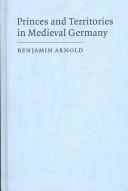| Listing 1 - 1 of 1 |
Sort by
|

ISBN: 0521390850 0521521483 051109776X 0511583672 9780521521482 9780511583674 9780521390859 Year: 2003 Publisher: Cambridge: Cambridge university press,
Abstract | Keywords | Export | Availability | Bookmark
 Loading...
Loading...Choose an application
- Reference Manager
- EndNote
- RefWorks (Direct export to RefWorks)
This book addresses the most important question in pre-modern German political history: why did a multiplicity of states and territories emerge by the end of the Middle Ages instead of an incipient 'nation state' under the crown? The answer is found not in the supposed failures of German kingship, but instead in the creative aristocratic successes of the secular dynasties and princes of the Church. We see how their collective efforts in the centuries after 1050 added up to a more markedly territorial structure of regional power, already emerging by the thirteenth century as a result of their endeavours in the economy, internal and external colonization, and the establishment of new castles, towns, monasteries and communications; in local, ecclesiastical and imperial law, and the jurisdictional reform which they imposed in their regions; and in the uses of dynastic politics, including feuds as well as alliances, inheritance and partition.
Constitutional history, Medieval. --- Nobility --- Histoire constitutionnelle médiévale --- Noblesse --- Germany --- Allemagne --- Politics and government --- Politique et gouvernement --- Constitutional history, Medieval --- -Noble class --- Noble families --- Nobles (Social class) --- Peerage --- Upper class --- Aristocracy (Social class) --- Titles of honor and nobility --- History --- -Germany --- -Constitutional history, Medieval. --- -History --- -Constitutional history, Medieval --- Histoire constitutionnelle médiévale --- Noble class --- To 1517 --- Germany - Politics and government - To 1517. --- Nobility - Germany. --- Arts and Humanities --- Acqui 2006 --- ALLEMAGNE --- POLITIQUE ET GOUVERNEMENT --- SAINT EMPIRE ROMAIN GERMANIQUE --- HISTOIRE --- MOYEN AGE --- MOYEN AGEALLEMAGNE
| Listing 1 - 1 of 1 |
Sort by
|

 Search
Search Feedback
Feedback About UniCat
About UniCat  Help
Help News
News